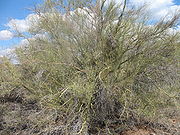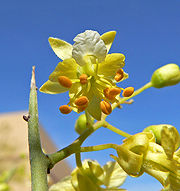
Parkinsonia microphylla
Encyclopedia
Parkinsonia microphylla (Yellow Palo Verde or Foothill Palo Verde; syn. Cercidium microphyllum) is a species of palo verde
native to the southwestern United States
(southeastern California
, southern Arizona
) and northwestern Mexico
(Sinaloa
, Sonora
, Baja California
).
 It is a bristling, upright-branching tree
It is a bristling, upright-branching tree
, mostly found on slopes, and is one of the most common trees of the Sonoran Desert. The species is slow-growing, sometimes living for several hundred years. It typically grows to heights of around 5 m, although rarely it can reach 6–7 m tall. The leaves
are yellowish green, and during extensively dry and hot periods the tree will shed them.
 The flowers of the palo verde, found on the end of a branch, are small, pale yellow and flower in late spring. The tree may not flower every year, depending on the amount rainfall. If there is enough rainfall, seeds will also appear in 4–8 cm long, soft pods which dip in between each seed. They ripen in July, and stick to the branches. Rodents will often carry and store the seeds underground, where some of them will germinate after a rainy season. The seedlings are very sensitive to drought for the first two to three months of their lives, and only about 1.6% will survive after germinating.
The flowers of the palo verde, found on the end of a branch, are small, pale yellow and flower in late spring. The tree may not flower every year, depending on the amount rainfall. If there is enough rainfall, seeds will also appear in 4–8 cm long, soft pods which dip in between each seed. They ripen in July, and stick to the branches. Rodents will often carry and store the seeds underground, where some of them will germinate after a rainy season. The seedlings are very sensitive to drought for the first two to three months of their lives, and only about 1.6% will survive after germinating.
 The Palo Verde has the characteristic of performing photosynthesis
The Palo Verde has the characteristic of performing photosynthesis
in its bark (hence the green color), and this is what allows it to survive after it has shed its leaves in hotter periods.
group of northwestern Mexico, call this tree ziipxöl ʃiːpχʷɬ . They used to grind up the seeds for flour, boil the green pods with meat, and eat the sweet green seeds as well as the flowers. They also strung the seeds for necklaces.
, an exotic species of grass native to Africa
and first introduced into the Sonoran desert for livestock grazing, spreads very quickly and will often kill palo verdes by taking away nearby water, which could pose a serious threat to the tree in the future.
Parkinsonia
Parkinsonia , also Cercidium , is a genus of flowering plants in the pea family, Fabaceae. It contains about 12 species that are native to semi-desert regions of Africa and the Americas...
native to the southwestern United States
Southwestern United States
The Southwestern United States is a region defined in different ways by different sources. Broad definitions include nearly a quarter of the United States, including Arizona, California, Colorado, Nevada, New Mexico, Oklahoma, Texas and Utah...
(southeastern California
California
California is a state located on the West Coast of the United States. It is by far the most populous U.S. state, and the third-largest by land area...
, southern Arizona
Arizona
Arizona ; is a state located in the southwestern region of the United States. It is also part of the western United States and the mountain west. The capital and largest city is Phoenix...
) and northwestern Mexico
Mexico
The United Mexican States , commonly known as Mexico , is a federal constitutional republic in North America. It is bordered on the north by the United States; on the south and west by the Pacific Ocean; on the southeast by Guatemala, Belize, and the Caribbean Sea; and on the east by the Gulf of...
(Sinaloa
Sinaloa
Sinaloa officially Estado Libre y Soberano de Sinaloa is one of the 31 states which, with the Federal District, comprise the 32 Federal Entities of Mexico. It is divided in 18 municipalities and its capital city is Culiacán Rosales....
, Sonora
Sonora
Sonora officially Estado Libre y Soberano de Sonora is one of the 31 states which, with the Federal District, comprise the 32 Federal Entities of Mexico. It is divided into 72 municipalities; the capital city is Hermosillo....
, Baja California
Baja California
Baja California officially Estado Libre y Soberano de Baja California is one of the 31 states which, with the Federal District, comprise the 32 Federal Entities of Mexico. It is both the northernmost and westernmost state of Mexico. Before becoming a state in 1953, the area was known as the North...
).
Overview

Tree
A tree is a perennial woody plant. It is most often defined as a woody plant that has many secondary branches supported clear of the ground on a single main stem or trunk with clear apical dominance. A minimum height specification at maturity is cited by some authors, varying from 3 m to...
, mostly found on slopes, and is one of the most common trees of the Sonoran Desert. The species is slow-growing, sometimes living for several hundred years. It typically grows to heights of around 5 m, although rarely it can reach 6–7 m tall. The leaves
Leaf
A leaf is an organ of a vascular plant, as defined in botanical terms, and in particular in plant morphology. Foliage is a mass noun that refers to leaves as a feature of plants....
are yellowish green, and during extensively dry and hot periods the tree will shed them.


Photosynthesis
Photosynthesis is a chemical process that converts carbon dioxide into organic compounds, especially sugars, using the energy from sunlight. Photosynthesis occurs in plants, algae, and many species of bacteria, but not in archaea. Photosynthetic organisms are called photoautotrophs, since they can...
in its bark (hence the green color), and this is what allows it to survive after it has shed its leaves in hotter periods.
Uses
The Seri people, a Native AmericanIndigenous peoples of the Americas
The indigenous peoples of the Americas are the pre-Columbian inhabitants of North and South America, their descendants and other ethnic groups who are identified with those peoples. Indigenous peoples are known in Canada as Aboriginal peoples, and in the United States as Native Americans...
group of northwestern Mexico, call this tree ziipxöl ʃiːpχʷɬ . They used to grind up the seeds for flour, boil the green pods with meat, and eat the sweet green seeds as well as the flowers. They also strung the seeds for necklaces.
Threats
BuffelgrassBuffelgrass
Cenchrus ciliaris is a species of grass native to most of Africa, southern Asia , Southern Iran, and the extreme south of Europe ....
, an exotic species of grass native to Africa
Africa
Africa is the world's second largest and second most populous continent, after Asia. At about 30.2 million km² including adjacent islands, it covers 6% of the Earth's total surface area and 20.4% of the total land area...
and first introduced into the Sonoran desert for livestock grazing, spreads very quickly and will often kill palo verdes by taking away nearby water, which could pose a serious threat to the tree in the future.

